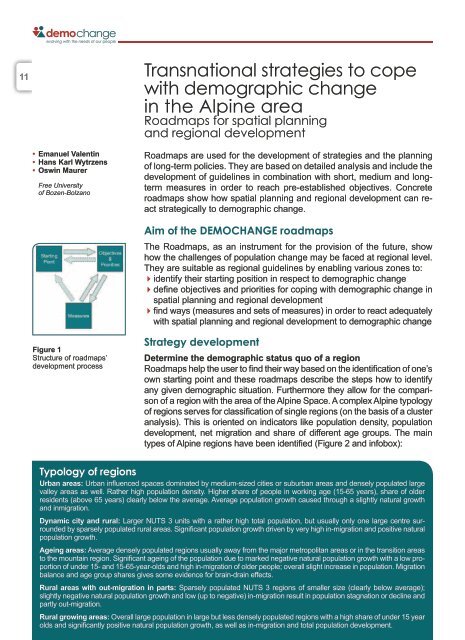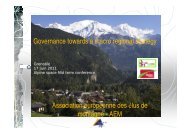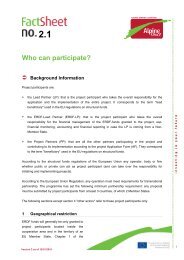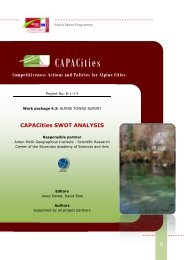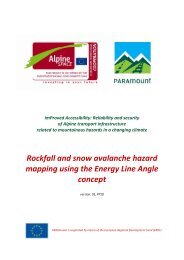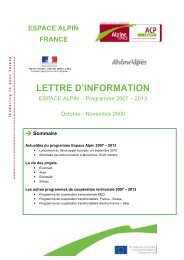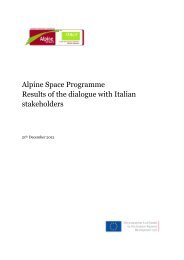aDaptation strategies to spatial planning anD regional Development
aDaptation strategies to spatial planning anD regional Development
aDaptation strategies to spatial planning anD regional Development
You also want an ePaper? Increase the reach of your titles
YUMPU automatically turns print PDFs into web optimized ePapers that Google loves.
11 Transnational <strong>strategies</strong> <strong>to</strong> cope<br />
with demographic change<br />
in the Alpine area<br />
Roadmaps for <strong>spatial</strong> <strong>planning</strong><br />
and <strong>regional</strong> development<br />
• Emanuel Valentin<br />
• Hans Karl Wytrzens<br />
• Oswin Maurer<br />
Free University<br />
of Bozen-Bolzano<br />
Roadmaps are used for the development of <strong>strategies</strong> and the <strong>planning</strong><br />
of long-term policies. They are based on detailed analysis and include the<br />
development of guidelines in combination with short, medium and longterm<br />
measures in order <strong>to</strong> reach pre-established objectives. Concrete<br />
roadmaps show how <strong>spatial</strong> <strong>planning</strong> and <strong>regional</strong> development can react<br />
strategically <strong>to</strong> demographic change.<br />
Aim of the DEMOCHANGE roadmaps<br />
The Roadmaps, as an instrument for the provision of the future, show<br />
how the challenges of population change may be faced at <strong>regional</strong> level.<br />
They are suitable as <strong>regional</strong> guidelines by enabling various zones <strong>to</strong>:<br />
identify their starting position in respect <strong>to</strong> demographic change<br />
define objectives and priorities for coping with demographic change in<br />
<strong>spatial</strong> <strong>planning</strong> and <strong>regional</strong> development<br />
find ways (measures and sets of measures) in order <strong>to</strong> react adequately<br />
with <strong>spatial</strong> <strong>planning</strong> and <strong>regional</strong> development <strong>to</strong> demographic change<br />
Figure 1<br />
Structure of roadmaps’<br />
development process<br />
Strategy development<br />
Determine the demographic status quo of a region<br />
Roadmaps help the user <strong>to</strong> find their way based on the identification of one’s<br />
own starting point and these roadmaps describe the steps how <strong>to</strong> identify<br />
any given demographic situation. Furthermore they allow for the comparison<br />
of a region with the area of the Alpine Space. A complex Alpine typology<br />
of regions serves for classification of single regions (on the basis of a cluster<br />
analysis). This is oriented on indica<strong>to</strong>rs like population density, population<br />
development, net migration and share of different age groups. The main<br />
types of Alpine regions have been identified (Figure 2 and infobox):<br />
Typology of regions<br />
Urban areas: Urban influenced spaces dominated by medium-sized cities or suburban areas and densely populated large<br />
valley areas as well. Rather high population density. Higher share of people in working age (15-65 years), share of older<br />
residents (above 65 years) clearly below the average. Average population growth caused through a slightly natural growth<br />
and inmigration.<br />
Dynamic city and rural: Larger NUTS 3 units with a rather high <strong>to</strong>tal population, but usually only one large centre surrounded<br />
by sparsely populated rural areas. Significant population growth driven by very high in-migration and positive natural<br />
population growth.<br />
Ageing areas: Average densely populated regions usually away from the major metropolitan areas or in the transition areas<br />
<strong>to</strong> the mountain region. Significant ageing of the population due <strong>to</strong> marked negative natural population growth with a low proportion<br />
of under 15- and 15-65-year-olds and high in-migration of older people; overall slight increase in population. Migration<br />
balance and age group shares gives some evidence for brain-drain effects.<br />
Rural areas with out-migration in parts: Sparsely populated NUTS 3 regions of smaller size (clearly below average);<br />
slightly negative natural population growth and low (up <strong>to</strong> negative) in-migration result in population stagnation or decline and<br />
partly out-migration.<br />
Rural growing areas: Overall large population in large but less densely populated regions with a high share of under 15 year<br />
olds and significantly positive natural population growth, as well as in-migration and <strong>to</strong>tal population development.


